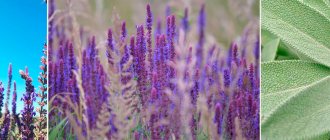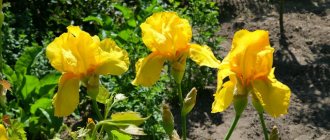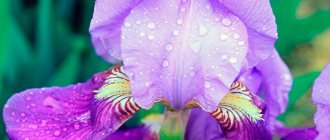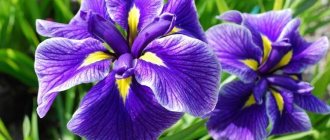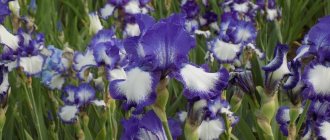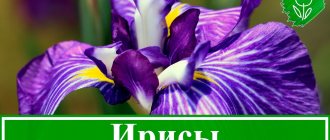Bulbous irises, which bloom in our areas along with other primroses, will help diversify the spring flower bed and add more bright colors to it.
Irises are a large group of perennial plants, among which there are a variety of species and varieties. They can be dwarf or giant, and also differ in the shape of the flowers and their color. Most irises are rooted plants, but in nature there are also bulbous specimens, which have been classified into 3 separate genera: Iridodictyum, Juno and Xiphion.
Iridodictium
This genus includes 11 species, growing mainly in the mountains of Central Asia and the Western Urals. These plants can also be found in the Caucasus and the Balkan Peninsula. That is why they take root well in the climate of the middle zone. Iridodictiums are considered the most resilient of all bulbous irises.
The name "iridodictium" comes from the Greek words "iris" (rainbow) and "diction" (mesh) - due to the bright color of the flowers and the mesh-like top layer of the bulbs.
Small plants belong to this genus. Iridodictiums grow to an average height of 15 cm. The leaves of the flowers are narrow and hard, appearing along with the buds. Each plant usually blooms only one flower, reaching 5-7 cm in diameter. Iridodictium flowers are very exotic, always with an unusual color and strong aroma.
Plants bloom in late March - early April and delight with their flowering for 2 weeks. These irises can grow in one place for up to 5 years.
Iridodictium Danfordiae
Iridodictium reticulatum
Iridodictium Katharine Hodgkin
Diseases
Iris can be affected by various diseases if not properly cared for. If the maintenance is poor, fungal and viral infections appear:
| Disease | Description | Fighting methods |
| Mosaic | Caused by aphids. Pathological stripes, yellowish spots of varying sizes and shapes appear on the greenery. The leaf plates become “crumpled” and embossed. The pathology spreads quickly. | The disease is infectious in nature, and there are no effective methods to combat it. To avoid occurrence, prevention is necessary: follow all watering rules, fertilize the plant. It is recommended to purchase insect pest repellents in the store and treat flowers with them: Actellik, Confidor. If the iris is still affected by the disease, the infected leaves must be destroyed immediately. |
| Bacterial rot | Brown spots form on the greens. The disease is detected in the spring after wintering. It is provoked by freezing of the rhizome, high soil moisture, close planting, and a lack of calcium and phosphorus in the substrate. | The affected leaves must be torn off and the injured area treated with a solution of potassium permanganate. If the pathology has affected the plant too much, it will have to be destroyed and the soil disinfected with purchased antibacterial agents (Maxim, Fitolavin). |
| Gray rot | Affects leaves or root system. Usually the disease occurs due to stagnation of moisture in the ground. Therefore, iris needs good drainage (with the exception of the swamp variety). Another reason is a lack of nutrients in the soil. | Treatment is carried out with fungicides (Trichofite, Fitodoctor, Fitosporin, Mikosan). When the pathological condition is advanced, the irises are destroyed. |
Juno
The genus Juno is more numerous than Iridodictium. It includes up to 40 species of bulbous plants that can be found in nature in the Caucasus, Asia Minor and Central Asia, South Africa and the Mediterranean.
These bulbous irises are named after the Roman goddess Juno, considered the patroness of women.
Different types of junos can vary in height: these irises grow from 10 to 50 cm. The leaves of the plants are located on the trunk in several rows. Flowers appear from the axils of the leaves and at the top of the stem. Thus, one specimen can have up to 10 buds.
Junos are most often found in white, yellow, purple and lilac. Flowers of many species have a rich aroma. Plants bloom in April-May for 2-3 weeks. Just like iridodictiums, they can grow in one place for up to 5 years.
Juno Bucharica
Juno Magnifica
Juno Orchioides
Xiphium
Xiphium Xiphion
This group of bulbous irises is the smallest. It includes only 6 species growing in the north-west of the Mediterranean coast. The climate of the middle zone is considered not very favorable for them, therefore, when grown in open ground, they need to be dug up every year.
Xyphiums get their name from the Greek word "xiphium" (sword) due to the shape of their leaves.
The leaves of Xyphiums are narrow and elongated. The flowers are quite simple compared to other bulbous irises. But they are quite large - they can reach 10 cm in diameter. At the same time, the height of plants varies - 30-80 cm (depending on the type and variety).
The color of the flowers is monochromatic: usually white, yellow, blue, indigo, violet. But there are also two-color specimens.
Xyphium Professor Blaauw
Xyphium White Excelsior
Xyphium Royal Yellow
Possible diseases and pests
Damage to various types of rot and bacteriosis occurs in contaminated soil or with excess moisture. The scales begin to rot, the nutrition of the aboveground part is disrupted, which affects the appearance - leaves, peduncles, flowers become sluggish, buds do not open.
The diseased plant is dug up, the affected areas of the bulb are cut off, washed in a fungicide solution and transplanted to a new location. The soil in the old place is treated with any fungicide.
Note for summer residents: Biofungicide “Fitosporin” - instructions for use
In spring, the cutworm butterfly is dangerous for irises - its larvae feed on young tender leaves and flower stalks. The drug Granozan, dug between plants, will serve as protection against the pest. In the fight against slugs that gnaw leaves and stems, crushed egg or nut shells and pine needles will help - they are distributed over the surface of the soil. You can set traps with beer, sugar water.
How to plant bulbous irises?
Bulbous irises should be planted in a sunny place protected from the wind. But an area with high groundwater levels is not very suitable for these plants. Irises do not grow well in damp places and often get sick.
Iris bulbs are planted in open ground in late September - early October. They prefer light and nutritious soil with a neutral reaction. Typically, the planting depth is equal to three times the height of the bulb. Therefore, depending on the size of the planting material, it will be different. The distance between plants should be equal to 3-4 bulb diameters.
Bulbous irises are planted in holes or grooves, after first pouring a small layer of sand on the bottom for drainage. In winter, it is advisable to cover the flowerbed with plants with peat, spruce branches or dry fallen leaves.
Landing Features
To grow irises, it is enough to provide them with a well-lit place. Successful growth in both full sun and partial shade is possible. In summer, it is better for the plant to have dry soil than too wet.
Did you know? bearded iris
is
the state flower of Tennessee and the official plant of February.
This way, the bulbs will have a better chance of flowering next year. To ensure consistent blooms for several years in a row, you can plant additional bulbs each fall, or grow this plant annually, planting new bulbs each fall.
Disembarkation time
The plant is planted in open ground with the onset of autumn (September). Plants take root better on warm September days and will produce beautiful spring blooms. In warm regions, planting can be delayed until mid-October.
It takes approximately 1.5 months to adapt and take root of the culture. If planted even later (in November), then the bulbous crop needs to be insulated for the winter. Otherwise, the bulbs simply will not have time to take root, and they may freeze in the winter cold.
There is useful information here on how to prepare the soil for planting irises.
Soil selection
Neutral acidity of the soil is quite suitable for irises; it is important that it is well drained. However, the ideal soil for the plant is limestone. An alkaline reaction is achieved by adding chalk, lime and egg shells to the soil.
The soil, which is dominated by sand, is supplemented with humus. It is worth adding ash and superphosphate to such soil in the ratio: 40 g of fertilizer per 1 m². Coarse sand, humus and compost are added to clay soil.
Important! If the soil is too wet and does not dry out well, the irises will dry out.
How to plant
Agricultural technology for irises depends on the variety. However, it is important for each of them:
- avoid excessive soil moisture;
- fertilize with mineral fertilizers in a timely manner;
- have access to sunlight.
To prevent dampness, it is better to plant flowers on a southern slope. You can artificially raise the flower bed by 25–30 cm. This will ensure a good outflow of water after rain.
Before landing you should:
- dig and loosen the soil;
- enrich with organic fertilizers.
Did you know? Vincent Van Gogh, a famous Dutch artist, painted 2 paintings depicting irises. These paintings are highly appreciated in the modern art world.
Planting is done with a bulb. It is worth considering some nuances:
- large bulbs are placed in the soil to a depth of 7-8 cm;
- small specimens are deepened by 3-4 cm.
The interval between planting holes must be at least 10 cm for single plantings. For group - place 10 bulbs close to each other. After planting, the ground is watered for better rooting.
What is the proper care for bulbous irises?
- In spring, you can remove the cover from bulbous irises quite early: after the snow has melted, but before the soil has completely thawed.
- The first fertilizing should be carried out after removing the cover with a mixture of nitrogen, phosphorus and potassium fertilizers in a ratio of 2:1:1.
- During budding, bulbous irises must be fed with nitrogen, phosphorus and potassium in a ratio of 3:1:2.
- A month after flowering, only phosphorus and potassium, taken in equal parts, need to be added to the irises.
- Plants should be watered in dry weather and during active growth and flowering. However, this should be done sparingly so as not to flood the irises.
- After watering, it is advisable to loosen the soil to prevent the formation of a soil crust.
- When the bulbous irises fade, watering should be stopped. After the leaves of the plants turn yellow, the bulbs can be dug up and stored.
- Before storing for winter storage, iris bulbs should be dried for 2-4 weeks. At this time, Iridodictiums and Junos must be kept at a temperature of 23-25°C, and Xyphium - 30-35°C. In this case, the humidity should be in the range of 60-80%. By the end of the drying period, the temperature must be reduced to 15-17°C and stored in such conditions until planting. Humidity should be high - about 80%.
Botanical description
Irises are a large group of perennials, numbering about 300 species. About 60 species are popular in Russia. It is the largest genus belonging to the genus of the family Iridaceae. Iris is an easy to grow butterfly attracting plant that is popular in many parts of the world. Irises can be very short, or quite tall specimens can be found. Differences in plants can be in the shape of flowers and color.
There are 2 main types of irises:
- rhizomatous (has a thick stem, grows horizontally and partially grows underground);
- bulbous (grow from bulbs. The main requirement is a mandatory dormant period after flowering).
Irises are one of the first to bloom, but the flowering period can vary, depending on climatic conditions and the variety. It can begin in May and continue until mid-summer. Almost all types of iris prefer fertile soil. However, there are species that can grow in swampy areas, and there are those that can withstand the harsh subarctic climate.
Iridodictium, Juno, Xyphium in garden design
Iridodictiums and junos look great with other bulbous plants, as well as primroses, decorating the site at the same time. These are crocuses, scillas, pushkinias, chionodoxes, snowdrops, primroses and hellebores. Xyphiums go well with perennials, such as buttercups or phlox.
In general, bulbous irises are suitable not only for growing in a flower bed, but also in a rock garden or on an alpine hill. They can also be planted in groups on the lawn. In addition, iridodictiums and xyphiums can be cut into bouquets.
Be sure to plant bulbous irises in the garden, because they beautifully decorate the area in early spring, when the garden is just awakening after winter hibernation.
